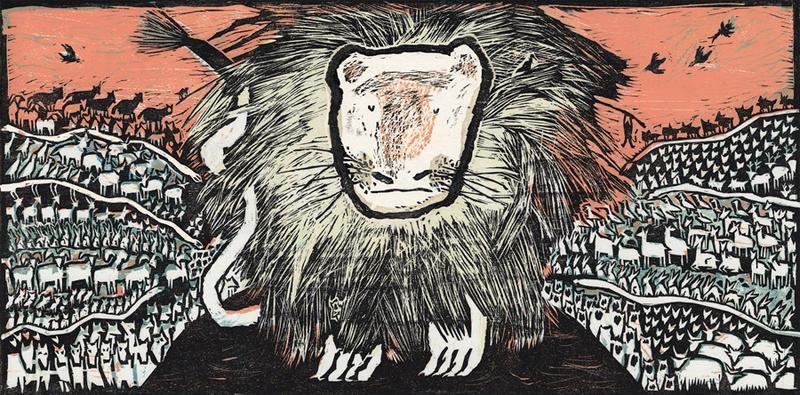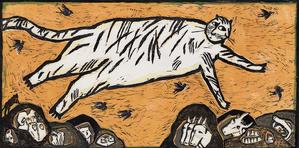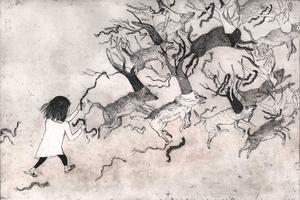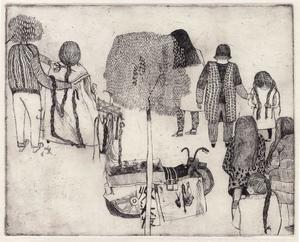Award-winning illustrator taps into traditional Chinese printing techniques to attract the attention of readers, Wang Qian reports.
 A page of illustrator Heimi's award-winning picture book, A Manul Who Wants Everything, depicts a manul (right) that tries to make the gray world in which it lives colorful with pigments from rocks. (PHOTO PROVIDED TO CHINA DAILY)
A page of illustrator Heimi's award-winning picture book, A Manul Who Wants Everything, depicts a manul (right) that tries to make the gray world in which it lives colorful with pigments from rocks. (PHOTO PROVIDED TO CHINA DAILY)
Inspired by a Qinghai province folk tale, A Manul Who Wants Everything tells the story of a Pallas's cat on a quest to change the gray world in which it lives.
Applying woodblock printing, an ancient art form that originated in China, illustrator Heimi (Huang Bingchun) hand-carved every block to produce the images and text in the picture book, giving it a nostalgically rustic and traditional aesthetic.
There is something magical about picture books, which can build a communication bridge beyond language and age
Heimi, illustrator in Beijing
In late February, the book was named as the winner of the Purple Island award at the 5th Nami Concours, a biennial international picture book illustration competition which, this year, attracted 2,069 artists from 95 countries and regions. The event aims to provide a platform for children's book illustrators around the world to showcase their talents to a global audience. Illustrations of the shortlisted candidates will be exhibited during the 2021 Nami Island International Children's Book Festival and included in the catalog.
Heimi says the award is "a great honor and recognition" and will motivate her in the advancement of her career as an illustrator.
Although not the first to do it, A Manul Who Wants Everything explores the expressive possibilities of woodblock printing in picture books.
"I tried various techniques, including ink, water color and collage, to match the story's temperament, but it didn't feel right until I tried woodblock printing," the illustrator, who now lives in Beijing, says. The technique's primitive beauty and simplicity echoes with the ancestral times in which the story takes place, she adds.
 With the cat's help, a lion shows up. (PHOTO PROVIDED TO CHINA DAILY)
With the cat's help, a lion shows up. (PHOTO PROVIDED TO CHINA DAILY)
Integrating painting, engraving and printing, woodblock printing dates back more than 1,200 years in China and is regarded as the world's earliest form of printing. It reached Europe around the 14th century and was used to print on paper to create "block books", which were mainly religious in nature, old master prints and playing cards.
The process takes time, and it took Heimi more than three years to finally finish the book. It was eventually published in 2019 by Shandong Pictorial Publishing House.
Before that, in 2018, she submitted some of her illustrations from the book to the Golden Pinwheel Young Illustrators Competition where they won that year's grand award.
Her talent was first recognized at the 2015 Biennial of Illustration in Bratislava, a major event of its kind supported by the International Board on Books for Young People; the Slovak Ministry of Culture and UNESCO. Her first book Braid won the BIB Golden Apple award.
"Imaginative details transform the monotone images and the ordinary domestic subject matter into a lively and poetic tale," the BIB jury said at the time.
 Painting black stripes on the animal, a tiger appears. (PHOTO PROVIDED TO CHINA DAILY)
Painting black stripes on the animal, a tiger appears. (PHOTO PROVIDED TO CHINA DAILY)
Picturing a career
Born in Chaozhou, Guangdong province, Heimi's passion for painting started early, at about 10 years old, when she spent most of her weekends and holidays in painting studios. Lucky to be born to parents who cared more about her innate talent than her school performance, Heimi became devoted to painting and, when she was in sixth grade, her father introduced her to watercolor master Yu Junxian for further study.
She graduated from Hubei Institute of Fine Arts in 2012, where she first encountered the art of printmaking, an artistic process based on the principle of transferring images from a matrix onto another surface, most often paper or fabric. Traditional printmaking techniques include woodcutting, etching, engraving and lithography.
In the first 10 months after her graduation, Heimi stayed at home trying to plot her career path, but one thing was certain, the rat race of the 9-5 lifestyle was not for her.
 The girl tries every way possible to extend her freshly shorn hair. (PHOTO PROVIDED TO CHINA DAILY)
The girl tries every way possible to extend her freshly shorn hair. (PHOTO PROVIDED TO CHINA DAILY)
Looking for a change of scene, Heimi moved to Beijing and joined author and illustrator Xiong Liang's studio, where she met a group of people that shared her interests, including her eventual editor and close friend Luo Xiting from Daylight Publishing House.
Luo became the editor for 2015's Braid, which marked the beginning of Heimi's life as a professional picture book illustrator. At the same time, she started to teach children painting and take commercial illustration and design work to make ends meet.
Applying the classical medium of copperplate etching, Braid is adapted from Heimi's graduation installation, which consisted of 15 copperplate images telling a story inspired by her childhood memories of the time when she lived with her grandma. It explores the inner thoughts of a little girl as her prized long hair is sold to a hair buyer. Shedding tears over her loss, the girl tries every way possible to extend her freshly shorn hair.
 Illustrator Heimi teaches children at a painting class in Beijing. (PHOTO PROVIDED TO CHINA DAILY)
Illustrator Heimi teaches children at a painting class in Beijing. (PHOTO PROVIDED TO CHINA DAILY)
When Luo first read the story, she thought it was a very Chinese tale and the use of etching helped the book achieve a rich effect, with expressive and crisp lines. Etching is a method of making prints from a metal plate, usually copper, into which the design has been incised by acid.
The book, in black and white, made Heimi the third Chinese entrant to win the BIB Golden Apple award, following in the footsteps of Cai Gao in 1993 and Yu Rong in 2013.
"Braid is more like a means of self-expression. Many scenes in the book are from my memory and together they become the story now," Heimi says, adding that details during her stay in her grandma's old house, such as the dents in a worn basin and a really old dog lying in the street, inspired her.
Different from her first book, the story in A Manul Who Wants Everything is not written by Heimi, and illustrating such a story was a new experience for her. The folk story was brought back by Xiong during a field trip to Qinghai in 2014.
 A page from Heimi's Braidshows a hair buyer coming to a village and a girl's prized long hair is sold by her grandma. (PHOTO PROVIDED TO CHINA DAILY)
A page from Heimi's Braidshows a hair buyer coming to a village and a girl's prized long hair is sold by her grandma. (PHOTO PROVIDED TO CHINA DAILY)
Building connection with the story was not easy, and the illustrator's breakthrough came on the back of a suggestion by a friend-to collect and observe rocks in different shapes and colors, which the cat in the story searches for to make pigments from.
The rocks helped Heimi get closer to the story and she began to model the cat in clay. After several adjustments, an image of the character gradually started to form, which was very similar to her own pet cat.
"Life has inspired my work in various ways. Observing the neighborhood, I usually get attracted to an object, a corner or a person, any of which may become a part of my illustrations later on," Heimi says.
 Book cover of Braid (left) and A Manul Who Wants Everything.
Book cover of Braid (left) and A Manul Who Wants Everything.
Universal appeal
Picture books are not an established genre in China and it is only with the exposure to Western books in recent years that there has been an increased interest in the art form.
Over the past decade, many Chinese illustrators, like Heimi, have gained international recognition. In 2016, Cao Wenxuan was named the winner of the Hans Christian Andersen Award for writers, making him the first Chinese author to claim the honor. Xiong made it to the illustrators' shortlist for the award in 2018.
In October, three Chinese authors-Xiong, Qin Wenjun and Zhang Zhilu-were nominated for the world's biggest children's literary prize, the Astrid Lindgren Memorial Award, a competition set up by the Swedish government in 2002 in memory of Lindgren, creator of the Pippi Longstocking books.
Increased communication with illustrators and writers abroad has expanded young artists' vision in picture books.
When attending the 2017 Bologna Children's Book Fair, Heimi was impressed by the Portuguese edition of Batata Chaca Chaca, a picture book by Yara Kono. In the book, the author has guests for dinner and a lot of ideas about how to prepare a very tasty meal. But, in order to have the meal ready on time, Yara requires help from the reader.
"Although I do not understand the text in its Portuguese edition, it warms my heart. There is something magical about picture books, which can build a communication bridge beyond language and age," Heimi says, smiling.
Contact the writer at wangqian@chinadaily.com.cn


